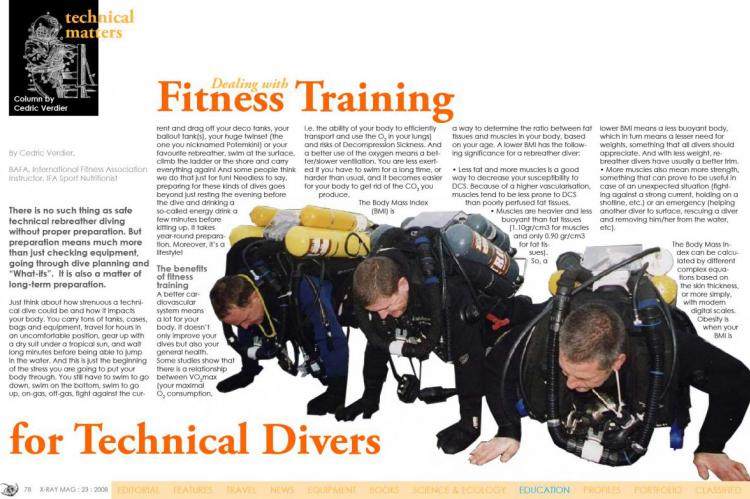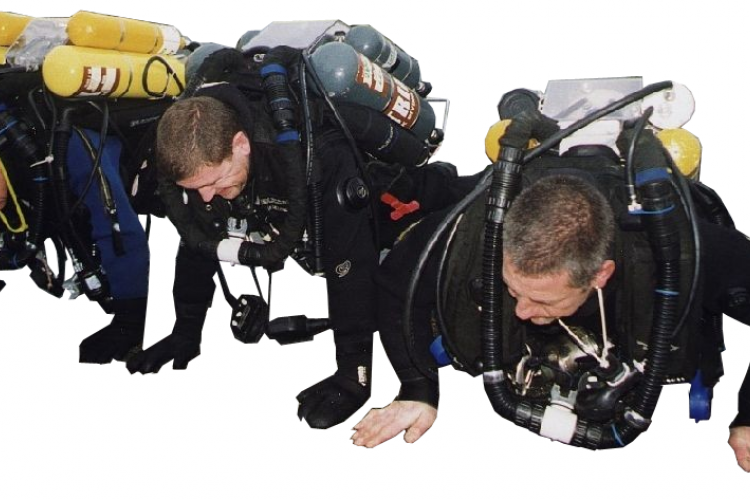Fitness for technical divers
There is no such thing as safe technical rebreather diving without proper preparation. But preparation means much more than just checking equipment, going through dive planning and “What-ifs”. It is also a matter of long-term preparation.
Tags & Taxonomy
And this is just the beginning of the stress you are going to put your body through. You still have to swim to go down, swim on the bottom, swim to go up, on-gas, off-gas, fight against the current and drag off your deco tanks, your bailout tank(s), your huge twinset (the one you nicknamed Potemkin!) or your favourite rebreather, swim at the surface, climb the ladder or the shore and carry everything again! And some people think we do that just for fun! Needless to say, preparing for these kinds of dives goes beyond just resting the evening before the dive and drinking a so-called energy drink a few minutes before kitting up. It takes year-round preparation. Moreover, it’s a lifestyle!
The benefits of fitness training
A better cardiovascular system means a lot for your body. It doesn’t only improve your dives but also your general health. Some studies show that there is a relationship between VO2max (your maximal O2 consumption, i.e. the ability of your body to efficiently transport and use the O2 in your lungs) and risks of Decompression Sickness. And a better use of the oxygen means a better/slower ventilation. You are less exerted if you have to swim for a long time, or harder than usual, and it becomes easier for your body to get rid of the CO2 you produce.
The Body Mass Index (BMI) is a way to determine the ratio between fat tissues and muscles in your body, based on your age. A lower BMI has the following significance for a rebreather diver:
• Less fat and more muscles is a good way to decrease your susceptibility to DCS. Because of a higher vascularisation, muscles tend to be less prone to DCS than poorly perfused fat tissues.
• Muscles are heavier and less buoyant than fat tissues (1.10gr/cm3 for muscles and only 0.90 gr/cm3 for fat tissues). So, a lower BMI means a less buoyant body, which in turn means a lesser need for weights, something that all divers should appreciate. And with less weight, rebreather divers have usually a better trim.
• More muscles also mean more strength, something that can prove to be useful in case of an unexpected situation (fighting against a strong current, holding on a shotline, etc.) or an emergency (helping another diver to surface, rescuing a diver and removing him/her from the water, etc).
Download the full article ⬇︎

Originally published
X-Ray Mag #23
In X-RAY MAG issue #23, Mark Webster takes on a tour through the fascinating underwater world off Cornwall, England. We talk with Pascal Bernabé for insights into his achievements in deep diving. Science editor, Michael Symes, investigates locomotion of sea creatures, and we look at Hammerhead sharks and their unique head shape. Harald Apelt brings us to another pearl in the Mediterranean -- beautiful, historic Croatia. Kurt Amsler discusses proper workflow in digital photography. Rebreather pro, Cedric Verdier, gets us up to speed on physical fitness for divers and DIR for rebreather divers. Girldiver Cindy Ross discusses sunscreen and gives us the skinny on sunrays and skin cancer. We meet the Bubbling Reefs of Denmark, and a diverse portfolio of ocean art from artists around the world tops it all off. Plus the news -- on marine ecology, discoveries, ship wrecks, conservation, equipment, travel, divers, record breakers, books and films, turtles, sharks, whales, jellyfish and more...



